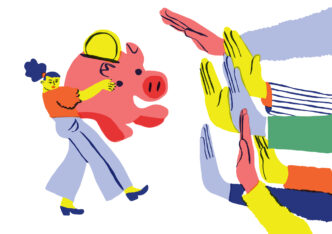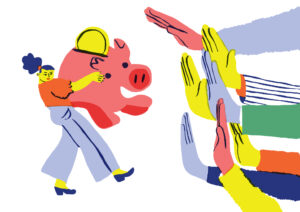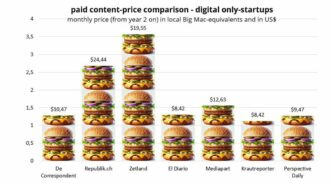
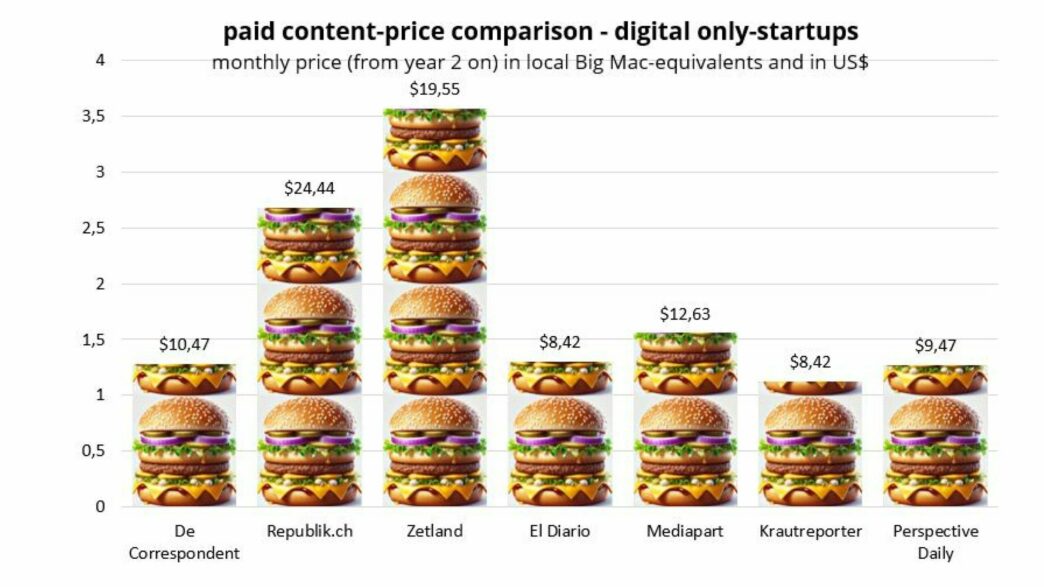
Warning, not to be read when hungry!
Article originally published in German on pv digest, a German language trade publication on the reader revenue side of journalism by Markus Schöberl.
A digital subscription to the New York Times currently costs long-term subscribers in the USA $27.08 per month; subscribers from Germany pay €13 per month from the second year onwards. The NZZ sells its digital subscription in Germany for €18.90 per month. Swiss citizens pay 32CHF for this. Membership of the Danish digital-only start-up Zetland costs 139 Danish kroner per month, while the Spanish digital-only start-up El Diario charges €8 – the same as the German Krautreportern, and similar to De Correspondent in the Netherlands, costing €9.85. Bildplus costs €7.99 and the Swedish Aftonbladet Plus costs 149 Swedish kronor. The Times Basic costs £15, whilst for the web and app content at Gazeta Wyborczca you pay 36.90zł per month.
In order to be able to compare the pricing of these and other media, we need a common basis. We often convert prices into euros or US dollars for this purpose, but even after conversion into the same currency, the prices are only comparable to a limited extent. Why? Because Americans, Germans, Swiss, Danes, Spaniards, Dutch, British and Poles live in countries with different income and price levels. An amount equivalent to $10 may seem low in one country and high in another.
To overcome this, The Economist came up with a pragmatic solution for comparing prices in different currencies: the Big Mac Index. As the name suggests, the idea is to use McDonalds’ Big Mac to compare prices, given that the same product, of the same quality, is sold in a wide variety of countries around the world.
Twice a year, The Economist calculates the Big Mac Index, publishing data to determine which currencies are over- or undervalued compared to the US dollar as the lead currency.
Using the same logic, I looked at the prices of well-known international paid content offers.
The Big Mac Index applied to publishing: The methodology
I converted the prices for monthly subscriptions into the number of Big Macs that could be bought in the respective country for the same amount (in local currency). For all non-EU countries except Switzerland, I used the Big Mac prices shown by The Economist in the latest update of its index.
This enables the comparison of subscription prices in local ‘Big Mac equivalents’
As The Economist Index is a currency valuation tool, it uses a single burger price for all countries in the eurozone: specifically, €5.67 for a Big Mac. It’s not entirely clear how they arrived at this – presumably averaged – price, but in order to compare prices between different EU countries for this analysis, I have researched current individual Big Mac prices for each EU country and for Switzerland. It turns out that between Paris (€7.70) and Vienna (€5.60), the Big Mac is very much underpriced.
For Switzerland, we see the current price at 8.20CHF – the Economist calculated at 7.20CHF in January.
For all other countries, we’ve used The Economist prices.
Prices for digital subscriptions in burger units: the results
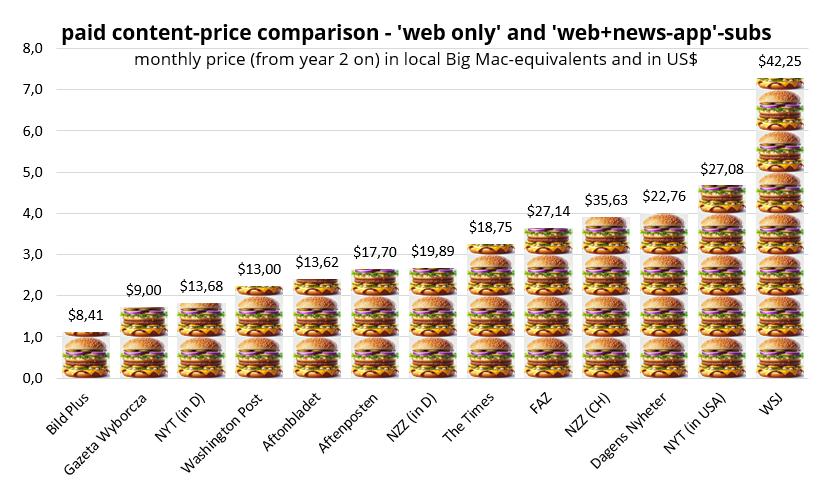
Prices of various basic digital subscriptions in local Big Mac equivalents (in D = Germany)
The cheapest paid content offer in this selection is the Bild newspaper. At a regular €7.99, the monthly subscription is only marginally more expensive than the Big Mac in Berlin (€7.09). The basic subscription to Gazeta Wyborcza, which is barely more expensive in US dollars, costs Poles significantly less in reality – the equivalent of 1.7 Big Macs.
If we compare Switzerland and Sweden, we can see how useful the Big Mac Index can be – although a subscription to Neue Zürcher Zeitung (NZZ) in Switzerland costs the equivalent of almost $36 and a subscription to Dagens Nyheter in Sweden only $23, the monetary value in both countries is equivalent to around 4 Big Macs.
The most expensive subscription – both in US$ and in local purchase price parity – is that of the Wall Street Journal.
Going deeper into the Big Mac Index comparison: Basic vs premium subscription offers
Many media differentiate between at least two digital subscriptions. A basic version, which only offers web access and perhaps an app, and a premium version, which also provides access to the e-paper or multimedia formats.
At FAZ in Germany, a basic subscription (FAZ+) converted into Big Macs above costs around $27 (€25.78) per month. However, if you also want to use the e-paper or the multimedia edition app, the subscription costs a good $50 (€47.90).
NZZ charges the Swiss almost twice as much for its most complete subscription, which includes the e-paper, as it does for the classic subscription, namely 61 instead of 32 francs per month. This means that the NZZ is selling the most expensive subscription in our sample. However, The Wall Street Journal is significantly more expensive in local Big Mac parities.
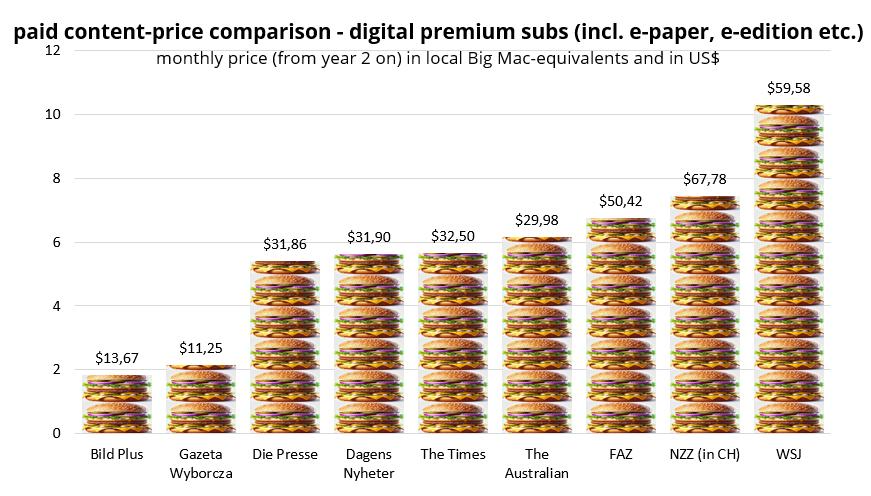
Prices of various all-inclusive digital subscriptions in local Big Mac equivalents
Many digital-only start-ups have opted for a price that corresponds to the value of around one and a half Big Macs in their respective countries. This applies to De Correspondent from the Netherlands, El Diario from Spain, Mediapart from France and the two German media outlets Krautreporter and Perspective Daily. Converted into dollars, the most expensive of these offers (Mediapart at $12.63 per month) is around 50% more expensive than the two cheapest (El Diario and Krautreporter, at $8.42 per month each).
The most expensive in this group are Republik.ch ($24.44) and Zetland ($19.55). The Conversion into burger units turns the order in the price of the media upside down (2.7 vs. 3.6 Big Macs).
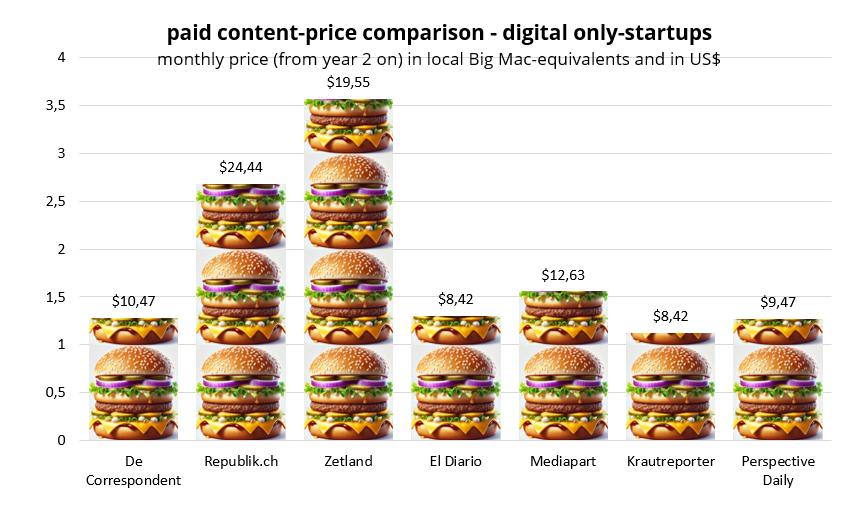
Prices of various digital-only paid content start-ups in local Big Mac equivalents
How have prices changed since 2021?
I already presented this analysis in the July 2021 issue. This gives me a basis for comparing the development of prices. Since then, MacDonald’s burger has become 33% more expensive on average in EU countries – 29% in Germany, 37% in Austria and 14% in Switzerland. In the USA, on the other hand, the Big Mac price remained almost stable during the period under review, while the overall inflation amounted to 16%.
Prices 2025 vs. 2021
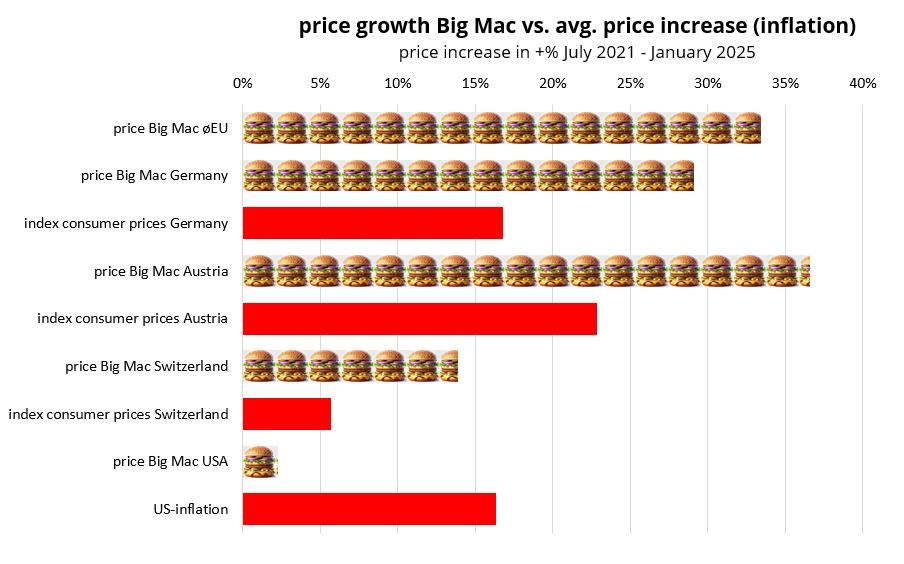
Comparison of % development of Big Mac prices and inflation
How did the prices of the media I looked at develop in the period from mid-2021 to early 2025?
A quarter of all the media brands studied here have not increased their subscription prices since my last analysis. The average price increase is 31%, or by 49% if I only consider the media with price increases.
But the mean values conceal a wide spread. While we see a significant reduction in prices for Aftenposten’s basic product, a minimal reduction for Perspective Daily, and unchanged prices for Bild and Die Republik, for example, the basic digital subscription of Dagens Nyheter has doubled in price and the basic offer of the Wall Street Journal is even four times more expensive.
If you place the change in Big Mac equivalents alongside the monetary price increases, it becomes clear that there can be considerable differences between price and value. For example, I recorded a price increase of 42% for the Dutch De Correspondent. But in local Big Mac units, the offer has become 11% cheaper. Overall prices in Big Mac units have risen less sharply than prices in the respective national currency.
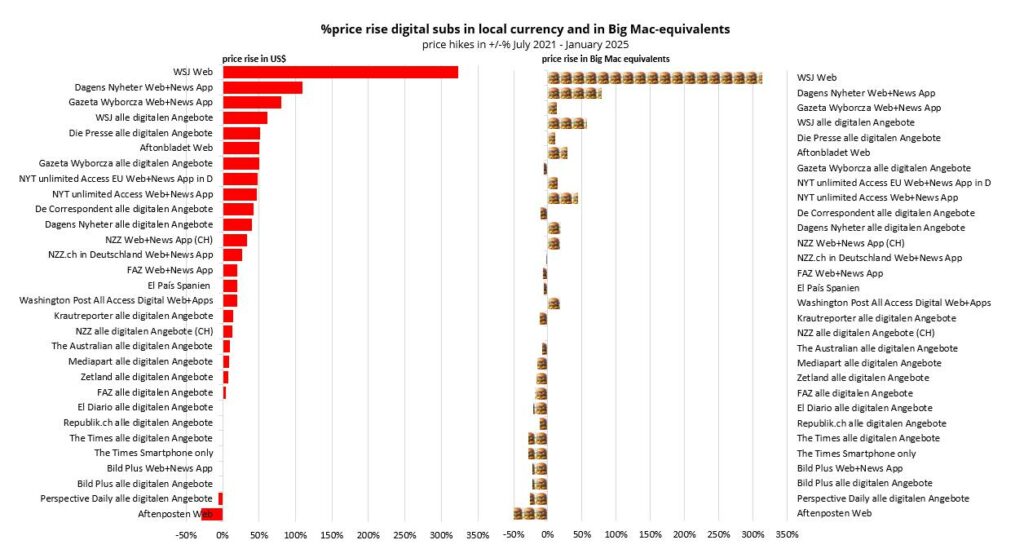
In conclusion, the Big Mac index makes for an interesting method to compare prices across currencies and countries and could be a useful way of developing a reasonable price for a subscription in a given context. For instance, as mentioned, many digital-only start-ups have opted for a price that corresponds to the value of around one and a half Big Macs in their respective countries.







